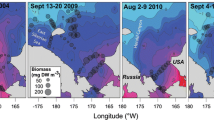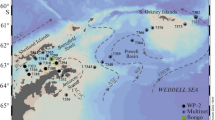Abstract
The Southern Ocean is a crucial component of the global climate system and plankton communities inhabiting the Ocean are important in the global carbon cycle. Our paper is aimed to reveal possible factors, which keep identity and explain changes of the community structure at the mesoscale. We tested the absolute values of environmental variables (e.g., temperature, salinity, chlorophyll) as well as the position of the oceanic frontal zones and water masses as these possible factors. We chose the epipelagic zone of the Drake Passage as a unique environment, where gradients of abiotic variables are the most sharp and the boundaries between water masses are not always coincident with the position of fronts: we recorded six water masses and two hydrological fronts. No strict connection between the position of hydrological fronts and absolute values of hydrological variables from one side, and community variables from another, was found. Instead, boundaries between communities coincided with the boundaries between water masses thus indicating greater importance of water mass origin and history and lesser importance of the current hydrological variables.
Similar content being viewed by others

References
Beal, L. M., W. P. M. De Ruijter, A. Biastoch, R. Zahn & SCOR/WCRP/IAPSO Working Group 136, 2011. On the role of the Agulhas system in ocean circulation and climate. Nature 472: 429–436.
Bernard, K. S. & P. W. Froneman, 2003. Mesozooplankton community structure and grazing impact in the Polar Frontal Zone of the south Indian Ocean during austral autumn 2002. Polar Biology 26: 268–275.
Botnikov, V. N., 1963. Geographic position of the zone of Antarctic Convergence in the Southern Ocean. Soviet Antarctic Expedition Information Bulletin 41: 324–327.
Boysen-Ennen, E. & U. Piatkowski, 1988. Meso- and macrozooplankton communities in the Weddell Sea, Antarctica. Polar Biology 91: 17–35.
Bray, J. R. & J. T. Curtis, 1957. An ordination of upland forest communities of southern Wisconsin. Ecological Monographs 27: 325–349.
Brodsky, K. A., 1950. Calanoida of the Far East and the Polar Basin. Leningrad Academy of Science Public House, 342 pp (In Russian).
Brodsky, K. A., N. V. Vyshkvartzeva, M. S. Kos & E. L. Markhaseva, 1983. Copepoda Calanoida of the seas of the USSR and adjastent seas. Opredeliteli po faune SSSR 35: 1–358 (in Russian).
Clarke, K. R. & R. M. Warwick, 2001. Changes in Marine Communities: An Approach to Statistical Analysis and Interpretation, 2nd ed. Plymouth, PRIMER-E.
Demidov, A. B., S. A. Mosharov, V. I. Gagarin & N. D. Romanova, 2011. Spatial variability of the primary production and Chlorophyll a concentration in the Drake Passage in the austral spring. Oceanology 51: 281–294.
Duro, A., A. Sabates & J. M. Gili, 1999. Mesoscale spatial distribution of chaetognaths along hydrographic gradients in the South Scotia Sea (Antarctica). Polar Biology 22: 195–206.
Fransz, H. G. & S. R. Gonzalez, 1995. The production of Oithona similis (Copepoda: Cyclopoida) in the Southern Ocean. ICES Journal of Marine Science 52: 549–555.
Hunt, B. P. V. & G. W. Hosie, 2006. The seasonal succession of zooplankton in the Southern Ocean south of Australia, part II: the Sub-Antarctic to Polar Frontal Zones. Deep-Sea Research I 53: 1182–1202.
Kirkwood, J. M., 1982. A guide to the Euphausiacea of the Southern Ocean. Information Services Section, Antarctic Division, Dept. of Science and Technology, Kingston.
Koshlyakov, M. N., I. I. Lisina, E. G. Morozov & R. Y. Tarakanov, 2007. Absolute geostrophic currents in the Drake Passage based on observations in 2003 and 2005. Oceanology 47: 451–463.
Koshlyakov, M. N., S. V. Gladyshev, R. Y. Tarakanov & N. I. Ryzhikov, 2010. Deep currents in the central part of the Drake Passage based on the data of the 2008 hydrographic survey. Oceanology 50: 821–828.
Labat, J.-P., P. Mayzaud, S. Dallot, A. Errhif, S. Razouls & S. Sabini, 2002. Mesoscale distribution of zooplankton in the sub-antarctic frontal system in the Indian part of the Southern Ocean: a comparison between optical plankton counter and net sampling. Deep-Sea Research I 49: 735–749.
Labat, J.-P., S. Gasparini, L. Mousseau, L. Prieur, M. Boutoute & P. Mayzaud, 2009. Mesoscale distribution of zooplankton biomass in the northeast Atlantic Ocean determined with an Optical Plankton Counter: relationships with environmental structures. Deep-Sea Research I 56: 1742–1756.
Markhaseva, E. L., 1996. Calanoid copepods of the family Aedideidae of the World Ocean. Proceedings of the Zoological Institute in St. Petersburg, St. Petersburg.
Mauchline, J. & L. R. Fisher, 1969. The biology of euphausiids. Advances in Marine Biology 7: 1–454.
McGillicuddy, D. J., 2016. Mechanisms of physical-biological-biogeochemical interaction at the oceanic mesoscale. Annual Review of Marine Science 8: 125–159.
Orsi, A., T. Whitworth & W. Nowlin, 1995. On the meridional extent and fronts of the Antarctic Circumpolar Current. Deep Sea Research I 42: 641–673.
Pakhomov, E. A. & P. W. Froneman, 2004. Zooplankton dynamics in the eastern Atlantic sector of the Southern Ocean during the austral summer 1997/1998 – Part 1: community structure. Deep Sea Research Part II 51: 2599–2616.
Pakhomov, E. A. & C. D. McQuaid, 1996. Distribution of surface zooplankton and seabirds across the Southern Ocean. Polar Biology 16: 271–286.
Pakhomov, E. A., H. M. Verheye, A. Atkinson, R. K. Laubscher & J. Taunton-Clark, 1997. Structure and grazing impact of the mesozooplankton community during late summer 1994 near South Georgia, Antarctica. Polar Biology 18: 180–192.
Pakhomov, E. A., R. Perissinotto, C. D. McQuaid & P. W. Froneman, 2000. Zooplankton structure and grazing in the Atlantic sector of the Southern Ocean in late austral summer 1993 Part 1. Ecological zonation. Deep-Sea Research I 47: 1663–1686.
Park, E. T. & F. D. Ferrari, 2009. Species diversity and distributions of pelagic calanoid copepods from the Southern Ocean. In Krupnik, I., M. A. Lang & S. E. Miller (eds), Smithsonian at the Poles: Contributions to International Polar Year science. Smithsonian Institution Scholarly Press, Washington, DC: 143–180.
Razouls, S., C. Razouls & F. De Bovee, 2000. Biodiversity and biogeography of Antarctic copepods. Antarctic Science 12: 343–362.
Rose, M., 1933. Faune de France. 26. Copepods Pelagiques. Typographie Firmin-Didot et cie, Paris.
Siegel, V. & U. Harm, 1996. The composition, abundance, biomass and diversity of the epipelagic zooplankton communities of the southern Bellingshausen Sea (Antarctic) with special reference to krill and salps. Archive of Fishery and Marine Research 44: 115–139.
Sokolov, S. & S. R. Rintoul, 2002. Structure of Southern ocean fronts at 140°E. Journal of Marine Systems 37: 151–184.
Sokolov, S. & S. R. Rintoul, 2009. Circumpolar structure and distribution of the Antarctic Circumpolar Current fronts: 1. Mean circumpolar paths. Journal of Geophysical Research: Oceans 114: 1–19.
Stupnikova, A. N. & A. L. Vereshchaka, 2012. High-resolution survey indicates high heterogeneity in copepod distribution in the hydrologically active Drake Passage. Journal of Natural History 47: 699–713.
Takahashi, K. T., A. Tanimura & M. Fukuchi, 1998. Long-term observation in zooplankton biomass in the Indian Ocean sector of the Southern Ocean. Memoirs of National Institute of Polar Research 52: 209–219.
Takahashi, K. T., S. Kawaguchi & M. Kobayashi, 2002. Zooplankton distribution patterns in relation to the Antarctic Polar Front Zones recorded by Continuous Plankton Recorder (CPR) during 1999/2000 Kaiyo Maru cruise. Polar Bioscience 15: 97–107.
Takahashi, K. T., S. Kawaguchi, G. W. Hosie, T. Toda, M. Naganobu & M. Fukuchi, 2010. Surface zooplankton distribution in the Drake Passage recorded by Continuous Plankton Recorder (CPR) in late austral summer of 2000. Polar Science 3: 235–245.
Voronina, N. M., 1998. Comparative abundance and distribution of major filter-feeders in the Antarctic pelagic zone. Journal of Marine Systems 17: 375–390.
Author information
Authors and Affiliations
Corresponding author
Additional information
Handling editor: Iacopo Bertocci
This research was performed in the framework of the state assignment of FASO Russia (theme No. 0149-2018- 0033).
Rights and permissions
About this article
Cite this article
Stupnikova, A.N., Tarakanov, R.Y., Kulagin, D.N. et al. Factors maintaining the identity of mesoplankton communities: cool evidence from the Drake Passage. Hydrobiologia 809, 221–232 (2018). https://doi.org/10.1007/s10750-017-3474-y
Received:
Revised:
Accepted:
Published:
Issue Date:
DOI: https://doi.org/10.1007/s10750-017-3474-y









